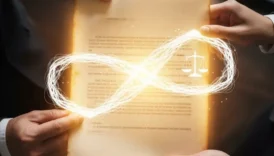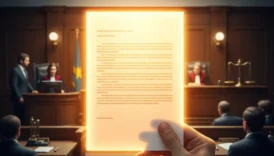What is a Declaratory Action? Clarifying Legal Rights Before Harm Occurs

In the world of law, lawsuits are typically associated with righting a wrong that has already happened—a breach of contract, a personal injury, or a damaged reputation. These actions seek compensation (damages) or a court order to force someone to do or stop doing something (an injunction). But what if you could resolve a legal uncertainty before anyone suffers harm or incurs significant damages?
This is where a powerful and proactive legal tool comes into play: the Declaratory Action, also known as a suit for declaratory judgment. It allows parties in a dispute to ask a court for a formal declaration of their rights, duties, or legal status without seeking any monetary award or coercive order.
Declaratory Action Definition: The Legal Meaning of the Concept
A Declaratory Action definition, at its core, is a legal proceeding where a court is asked to issue a binding judgment that clarifies an uncertain legal relationship or resolves a legal question between the parties. The primary purpose is not to punish past conduct but to prevent future litigation and guide future actions by removing uncertainty.
The meaning of a Declaratory Action can be best understood through its key characteristics:
- It is Preventive: The goal is to establish rights and obligations to prevent a full-blown, damage-causing legal battle from erupting.
- It Seeks No Damages: The plaintiff is not asking for money. They are asking for clarity. The output is a “declaration,” not a check.
- It Requires a Real Dispute: Courts will not entertain hypothetical questions. There must be an “actual controversy” between parties with genuine adverse legal interests.
- The Judgment is Binding: Although no damages are awarded, the court’s declaration is a final, legally binding decision that resolves the issue and has the force of law for the parties involved.
In essence, a declaratory action answers the question, “What are our legal rights in this situation?” rather than “Who owes whom money for what happened?” It’s a tool for legal certainty in a world of complex contracts, patents, and regulations.
The Purpose and Essential Requirements
A declaratory action is not a legal tool to be used lightly. Courts have specific criteria that must be met before they will agree to hear such a case. Understanding both the strategic purpose and the legal requirements is key to grasping the doctrine’s power.
The Primary Purpose: Why File for a Declaration?
Parties typically seek a declaratory judgment for one overarching reason: to resolve legal uncertainty and mitigate risk. Instead of waiting for a potential legal storm to hit, a declaratory action allows them to determine its path beforehand. Key strategic purposes include:
- Validating a Course of Action: A company might want to launch a new product but fears it could infringe on a competitor’s patent. Instead of investing millions and risking a costly infringement lawsuit later, they can file a declaratory action asking the court to declare that their product does not infringe.
- Clarifying Contractual Obligations: Imagine a complex commercial lease with an ambiguous clause about maintenance responsibilities. Before either the landlord or tenant spends a significant amount of money on repairs, one party can ask a court to declare the proper interpretation of the clause.
- Confirming Non-Liability: If you have been threatened with a lawsuit but believe the other party’s claim is invalid, you can proactively file a declaratory action to have a court confirm that you are not liable. This shifts the dynamic, allowing you to take control of the situation rather than waiting to be sued.
The Crucial Requirement: An “Actual Controversy”
This is the most important gateway to a declaratory judgment. U.S. federal courts and most state courts are constitutionally prohibited from issuing “advisory opinions”—that is, giving advice on hypothetical situations. For a court to have jurisdiction, there must be an “actual controversy” (or a “justiciable controversy”).
This means:
- There is a Real Dispute: The disagreement between the parties must be concrete and definite, not theoretical or abstract. A vague fear of a future lawsuit is not enough.
- The Parties Have Adverse Legal Interests: The parties must be on opposite sides of the legal issue, with one side asserting a right and the other denying it.
- The Issue is Ripe for Decision: The facts must be sufficiently developed so that the court can make a conclusive ruling.
A classic example is in patent law: A patent holder sending a cease-and-desist letter to a manufacturer creates an actual controversy. The manufacturer now has a reasonable fear of being sued and can therefore file a declaratory action to determine the patent’s validity or whether their product infringes. Without that letter, the fear might be considered too speculative for a court to hear.
Common Applications of Declaratory Actions
The true value of a declaratory action is revealed in its practical applications across various fields of law. It serves as a crucial mechanism for resolving disputes proactively in complex situations. Here are some of the most common areas where declaratory judgments are sought:
1. Insurance Coverage Disputes
This is one of the most frequent uses of declaratory actions. When there is a disagreement about whether an insurance policy covers a specific event, either the insurance company or the policyholder can seek a declaration.
- Example from the Insurer’s side: A person is sued after a car accident. Their insurance company believes the accident is not covered under the terms of the policy (e.g., they were using the car for a prohibited commercial purpose). Instead of refusing to defend the person and risking a massive “bad faith” lawsuit later, the insurer can file a declaratory action asking the court to declare that it has no duty to defend or pay for the claim.
- Example from the Insured’s side: Conversely, if the insurance company denies coverage for a claim, the policyholder can file a declaratory action to have the court affirm that the claim is, in fact, covered and the insurer must fulfill its obligations.
2. Intellectual Property (IP) Law
Declaratory actions are a cornerstone of intellectual property litigation, particularly in patent, trademark, and copyright law.
- Patent Non-Infringement: As discussed earlier, a company planning to launch a new product can seek a declaration that its product does not infringe on a competitor’s patent, especially after receiving a threatening letter. This allows them to clear the legal air before committing to a full-scale market release.
- Patent Invalidity: A party can also ask a court to declare that a competitor’s patent is invalid in the first place (e.g., because the invention was not truly novel).
- Copyright and Trademark: A declaratory action can be used to determine the true owner of a copyright for a piece of creative work or to resolve whether a proposed business name is confusingly similar to an existing trademark.
3. Contract Law and Commercial Disputes
When the language in a contract is ambiguous or the parties disagree on its meaning, a declaratory action can provide clarity before a breach occurs.
- Clarifying Rights and Obligations: Parties to a long-term supply agreement might disagree on a price adjustment clause. A declaratory judgment can interpret the clause, preventing one party from terminating the contract or suing for breach.
- Validating a Contract: A party can seek a declaration that a contract is valid and enforceable when the other party is claiming it is void.
4. Real Estate and Property Law
Disputes over property rights are another fertile ground for declaratory actions. Parties can seek declarations to resolve issues concerning:
- The exact location of a property line.
- The validity or scope of an easement (the right to use another’s land for a specific purpose).
- The interpretation of restrictive covenants in a subdivision.
Conclusion: A Tool for Proactive Legal Strategy
The Declaratory Action stands apart in the legal landscape not as a sword for punishing past wrongs, but as a shield for preventing future ones. Its power lies in its proactivity. By providing a binding judicial determination of rights and obligations, it replaces costly uncertainty with legal clarity.
For businesses navigating complex contracts, innovators protecting their intellectual property, and individuals seeking to understand their duties under an agreement, the declaratory judgment is an indispensable strategic tool. It allows parties to manage risk, validate their legal positions, and often avoid the far greater expense and disruption of a traditional lawsuit for damages. In a world where legal disputes can arise from ambiguity, the declaratory action offers a clear and authoritative path forward.
Frequently Asked Questions (FAQ) about Declaratory Actions
How is a declaratory action different from a regular lawsuit?
The main difference is the remedy sought. A regular lawsuit typically seeks damages (monetary compensation) or an injunction (a court order to do or stop doing something) to fix a harm that has already occurred. A declaratory action seeks only a binding legal declaration from the court to clarify rights and prevent future harm. No money is awarded, and no orders are issued.
Is a declaratory judgment legally enforceable?
Yes. While it doesn’t award damages, the court’s declaration is a final and legally binding judgment. It conclusively settles the legal issue between the parties. If a party ignores the declared rights and obligations, the winning party can then file a subsequent lawsuit (for damages or an injunction) where the declaratory judgment will serve as established proof.
Can I get money from a declaratory action?
No, not directly. The purpose of the action is to receive a legal declaration, not a monetary award. However, by clarifying your rights, a favorable judgment can prevent you from losing money in the future or set the stage for a separate lawsuit where you could recover damages.
Do I need a lawyer to file a declaratory action?
Yes. A declaratory action is a complex legal proceeding that involves navigating specific procedural rules and meeting a high burden of proof (like the “actual controversy” requirement). Due to its complexity and the binding nature of the outcome, it is essential to have a qualified attorney represent you.
Author’s Note
This article is presented as part of our commitment to demystifying complex legal topics and fostering a greater understanding of the law. The legal system contains many powerful tools, and we believe that informed individuals and businesses are better equipped to navigate their rights and responsibilities.
Please be aware that the information provided in this article is for general informational purposes only and does not constitute legal advice. The law is nuanced and its application can vary dramatically based on the specific facts of your situation and your jurisdiction. This content is not intended to create, and receipt of it does not constitute, an attorney-client relationship.
For guidance on any specific legal issue or concern, we strongly recommend consulting with a qualified and licensed attorney.






